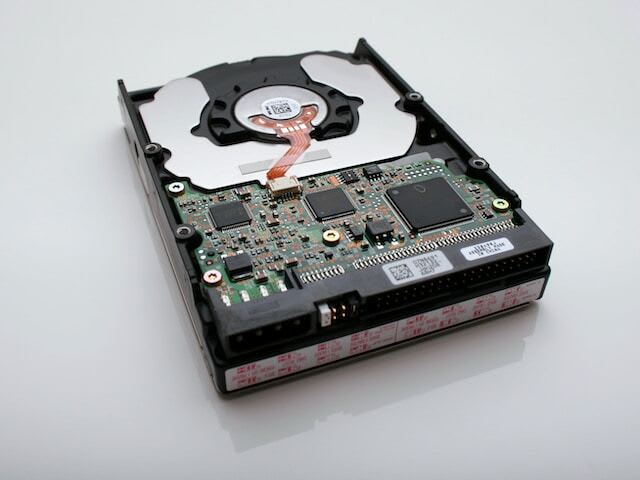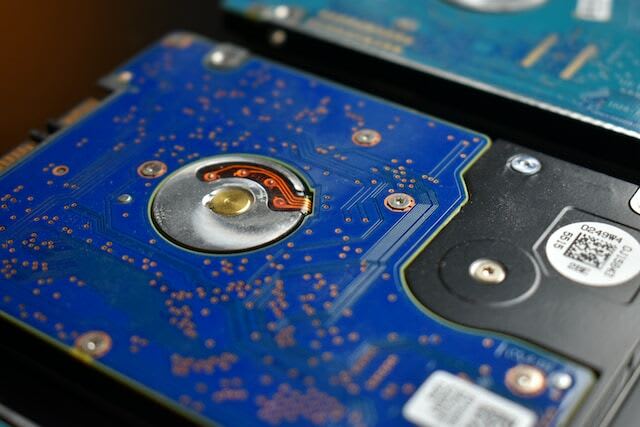Managing storage on a Windows PC can be tricky. Picking between Basic and Dynamic Disk options is especially confusing for newbies. So, before you do anything, it's important to understand the difference. Basic disks are great for simple setups, while Dynamic disks are more advanced and better suited for big companies. In this article, I'll go over the pros and cons of both disks, so you can pick the right one for your Windows PC.
Understanding the Difference between Basic Disk and Dynamic Disk
You may have heard the words 'basic disk' and 'dynamic disk' when it comes to managing hard drive partitions on your Windows PC. So, what precisely are they, and how do they differ from one another?
What is a Basic Disk?
A basic disk is the classic hard drive configuration that has existed since DOS. It divides the disk into portions using partitions, with each partition allocated a drive letter. A standard drive may support up to four primary partitions or three primary partitions and one extended partition. A basic disk's partitions can alternatively be formatted using a different file system, such as NTFS or FAT32.
What is a Dynamic Disk?
In contrast, a dynamic disk is a modern disk design that provides for more extensive disk management functions. A dynamic disk, rather than partitions, employs 'volumes' that can span many physical drives. Volumes on a dynamic disk may be readily expanded or contracted without causing data loss or downtime. Furthermore, dynamic disks support features like fault tolerance and software RAID.
Key Differences between Basic and Dynamic Disk
The primary distinction between basic and dynamic disks is that basic disks employ partitions, whereas dynamic disks employ volumes. Basic drives can only have four partitions (three primary and one extended), but dynamic disks can have an infinite number of volumes. More advanced features, such as disk spanning, fault tolerance, and software RAID, are also supported by dynamic disks.
Advantages and Disadvantages of Basic Disk
A basic disk is a type of disk storage that uses partitions to organize data. A partition is a logical division of a disk that can have its own file system and drive letter. A basic disk can have up to four primary partitions, or three primary partitions and one extended partition. An extended partition can contain multiple logical drives, which are also called volumes.
Advantages of Basic Disk
Disadvantages of Basic Disk
Advantages and Disadvantages of Dynamic Disk
A dynamic disk is a type of disk that uses a database to store information about partitions (also called volumes) instead of a partition table. A dynamic disk can have different types of volumes, such as simple, spanned, striped, mirrored, or RAID-5 volumes. A dynamic disk can also support both MBR and GPT partition styles. A dynamic disk offers some advantages over a basic disk, but also some disadvantages.
Advantages of Dynamic Disk
Disadvantages of Dynamic Disk
How to Convert Basic Disk to Dynamic Disk
There are a few things you should think about before converting a basic disk to a dynamic disk.
Converting Basic Disk to Dynamic Disk: Step-by-Step Guide
A basic disk is a type of disk that uses partitions to organize data. A dynamic disk is a type of disk that uses volumes to organize data. Volumes can span multiple disks, provide fault tolerance, and offer more flexibility than partitions.
To convert a basic disk to a dynamic disk, you need to follow these steps:
- Back up any important data on the disk that you want to convert. Converting a basic disk to a dynamic disk will not delete any existing data, but it is always a good idea to have a backup in case something goes wrong.
- Open Disk Management by pressing Windows + R, typing diskmgmt.msc, and clicking OK.
- Right-click the basic disk that you want to convert and select Convert to Dynamic Disk.
- Select the disks that you want to convert and click OK.
- Click Convert and then click Yes to confirm.
- Wait for the conversion process to complete. You may need to restart your computer for the changes to take effect.
Things to Consider before Converting Basic Disk to Dynamic Disk
How to Convert Dynamic Disk to Basic Disk
If you've already set up your disk as a dynamic disk and discovered you need to convert it to a basic disk, don't panic - it's simple to do so. Remember that switching your drive from dynamic to basic will wipe all volumes on the disk, so make sure you have a backup of your data before proceeding.
Converting Dynamic Disk to Basic Disk: Step-by-Step Guide
Dynamic disks may generate volumes that span several drives, such as striped, mirrored, or RAID-5 volumes. Basic disks are disks that may be used to build main and extended partitions, as well as logical drives within extended partitions. For compatibility or performance reasons, you may want to convert a dynamic disk to a simple disk. This method, however, is not simple and takes some meticulous measures. This article will walk you through the process of converting a dynamic disk to a simple disk without losing data.
Things to Consider before Converting Dynamic Disk to Basic Disk
A dynamic disk is a disk configuration that lets you to construct several sorts of volumes, such as basic, mirror, or striped, that can span numerous drives or employ sophisticated capabilities such as RAID. A basic disk configuration is a more popular sort of disk configuration that allows you to build up to four primary partitions or three primary partitions and one extended partition using logical drives.
If you want to convert a dynamic disk to a basic disk, you need to be aware of some important considerations:
It is not difficult to convert a dynamic disk to a basic disk, but it does need careful planning and preparation. Make sure you understand the benefits and drawbacks of each disk setup and select the one that best meets your needs.
Factors to Consider Before Choosing Basic or Dynamic Disk
The choice between basic and dynamic disk is critical for your Windows PC. Here are some things to think about when making your decision.
Storage Requirements and Volume Size
Basic disks are more suited to modest storage needs, but dynamic disks are better suited to greater volume capacities. Dynamic disks may produce an infinite number of volumes, including spanned, striped, and mirrored volumes, whereas basic disks are restricted to four primary partitions or three primary partitions and one extended partition.
Operating System and Compatibility
Basic disks are supported by all versions of Windows, whereas dynamic disks are only supported by Windows Professional and Enterprise. Furthermore, if you intend to dual boot your system, you'll need to select basic disks for compatibility.
Security and Data Recovery Options
Basic disks offer a more straightforward and safe method of storing data, whereas dynamic disks offer more complex capabilities such as software-based RAID, which can boost performance and data redundancy. However, the additional complexity of dynamic disks can make data recovery and backup more difficult.
Choosing the Right Disk for Your Windows PC: Best Practices
Here are some best practices to remember when selecting the right disk for your Windows PC.
Key Considerations for Choosing the Right Disk
When deciding between basic and dynamic disks, consider storage requirements, operating system compatibility, and data recovery options. Consider your individual requirements, such as software-based RAID or the amount of partitions you require.
Best Practices for Disk Management and Maintenance
Keep your disks clean by constantly eliminating unwanted files and software, using disk cleanup tools, and defragmenting your drives on a regular basis. You may also make frequent backups of your data to avoid data loss in the event of a disk failure.
Conclusion
Deciding whether to go for a basic or dynamic disk is all about what you need and like. Basic disks are straightforward and work with various operating systems, but they have a few drawbacks when it comes to managing partitions and keeping your data safe. Dynamic disks are more adaptable and potent, but they're only compatible with newer editions of Windows and might not play nice with all apps or gear.
If you're just looking to make some simple partitions and want to make sure they work with other systems or devices, go for basic disks. But if you need to make more complicated volumes that span multiple disks, or you want to change the size of your volumes without losing anything, dynamic disks might be a better fit for you.
Hey, just a heads up - if you're thinking of changing a disk from basic to dynamic or the other way around, make sure you've backed up all your important stuff and know what you're getting into. Going from basic to dynamic is usually a piece of cake and won't mess up any existing partitions or volumes. But if you wanna go from dynamic to basic, you gotta wipe out all the volumes on the disk, which could lead to losing data or messing up your system. So be careful!
FAQs
Can I convert a Basic Disk to a Dynamic Disk?
Yes, a Basic Disk can be converted to a Dynamic Disk. It is important to remember, however, that this operation entails the destruction of all data on the drive. As a result, before converting the drive, make a backup of all data.
Can I convert a Dynamic Disk to a Basic Disk?
Yes, a Dynamic Disk can be converted to a Basic Disk. This method, however, will result in the deletion of all volumes on the dynamic drive, and you will lose all data as a result. As a result, before converting the drive, make a backup of all data.
Which disk is better for a Home PC?
A Basic Disk is usually suitable for most simple disk setups on a Home PC. Basic disk provides a simple and robust disk management solution that is simple to use. It is also Windows-compatible and may be utilized for data storage, program installation, and dual boot scenarios.
Which disk is better for an Enterprise-level system?
Because it includes advanced features such as disk spanning, disk striping, and fault tolerance, Dynamic Disk is better suited for enterprise-level systems. These characteristics are critical for systems that demand high performance, redundancy, and data security. It is crucial to note, however, that Dynamic Disk necessitates a somewhat greater degree of technical competence and is not as simple to administer as Basic Disk.
Thank you for reading!
Soumyadeep Mandal @imsampro














Top comments (1)
Basic Disk or Dynamic Disk: Which one to Choose for Your Windows PC?
Devto: dev.to/imsampro/basic-disk-or-dyna...
Hahnode: imsampro.hashnode.dev/basic-disk-o...
Medium: imsampro.medium.com/basic-disk-or-...
LinkedIn: linkedin.com/pulse/basic-disk-dyna...
🌟➡️ Follow @imsampro for more awesome contents and updates!
#dynamicdisk #basicdisk #windows #beginners #guide #disk #disks #data #partitions #compatibility #drives #software #backup #storage